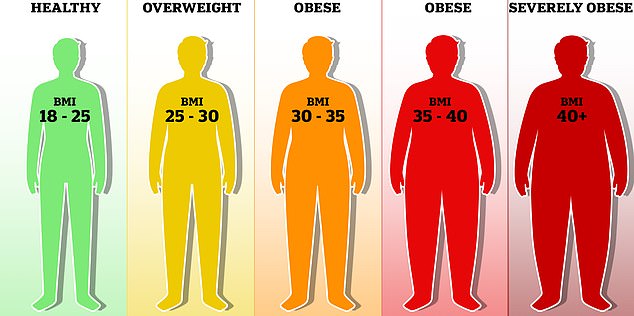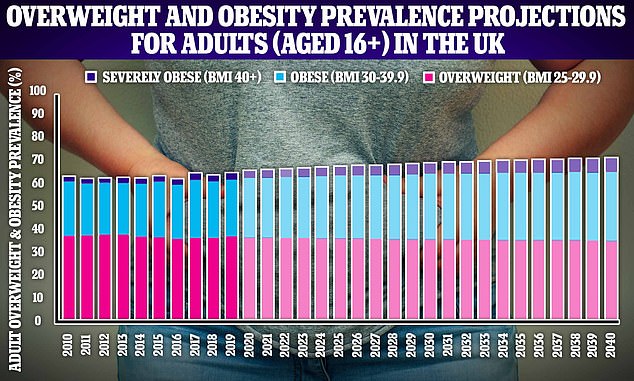Millions more Britons could be labeled as obese in a major proposed shake-up of the body mass index (BMI) classification system.
The height-to-weight ratio is supported by the World Health Organization and is used by doctors to determine whether a person is at risk of a number of diseases such as diabetes, heart attacks and strokes due to excess fat.
Under the current system, a score of 18.5 to 25 is healthy. A score of 25 to 29 counts as overweight, and more than 30 means that a person is obese, a stage at which the chances of getting sick skyrocket.
But now Italian research suggests the model needs an overhaul for those over 40 and anyone with a BMI of 27 or more should be classed as obese.
NHS data shows that only 26 per cent of adults have a BMI over 30.
Celebrities such as Avengers star Chris Hemsworth, Australian actress Rebel Wilson and Britain’s Tom Hardy would also technically fall into an “obese” BMI under the proposed change.

According to the BMI system, a score of 18.5 to 25 is healthy. A score of 25 to 29 counts as overweight, and more than 30 means that a person is obese, a stage at which the chances of getting sick skyrocket.

More than 42 million adults in the UK will be overweight or obese by 2040, according to Cancer Research UK projections
But the average BMI of all adults aged over 40 in the UK ranges between 27.7 and 27.6, suggesting the majority would be declared obese and at risk under the proposed reform.
It means that many people could, in theory, be obese without realizing it.
Celebrities such as Avengers star Chris Hemsworth, Australian actress Rebel Wilson and British celebrity Tom Hardy would also technically fall into an “obese” BMI with the changes.
Presenting their findings at the European Obesity Congress in Venice, the authors of the new study said the current BMI cutoff for obesity may not be suitable for middle-aged and older adults.
They said people over 40 have greater fat accumulation around the waist which, combined with age-related muscle decline, means there is no overall change in overall weight.
This means that despite accumulating flab, the BMI system fails to raise the alarm and people do not realize that they are at risk of obesity-related health problems.
The researchers backed up their findings with a study of 4,800 Italian adults, ages 40 to 80, split roughly equally between men and women.
Of this group, 38 percent and 41 percent of women had a BMI of 30 or higher, obese by current standards.
However, when researchers used high-tech scanners to measure their actual body fat percentage, 71 percent of men and 64 percent of women were assessed as obese.
This meant that almost half of men and women with worrying levels of fat were being falsely reassured by the BMI system.
Comparing the findings, they found that using a BMI cutoff of 27 for obesity covered almost 9 in 10 of the obese patients detected in the body scan method.
Study author Professor Marwan El Ghoch, an expert in metabolic health at the University of Modena and Reggio Emilia, said: “This new BMI limit recognizes the physiological differences between middle-aged and older adults and younger populations. “.
Professor Antonino De Lorenzo, co-author and biomedical expert at the University of Rome, added: “If we continue to use the WHO standard for obesity screening, we will miss many middle-aged and older adults who are at risk of obesity. suffer from obesity.” Related diseases, such as type 2 diabetes, heart disease, and some cancers.
“Establishing this new BMI cutoff point in clinical settings and in obesity guidelines will be beneficial to the potential health of millions of older adults.”
The study, which was presented at the conference, said its work has limitations.
For example, it was carried out in one part of Italy, so the findings may not apply to other parts of the world.
Another was that they didn’t take into account other factors such as diet, exercise levels and sleep patterns, which could also influence obesity among participants, not just age.
They called for similar studies to be carried out on a larger scale in other parts of the world to confirm their results.
Experts have previously criticized BMI as a measure of health.
Devised by a Belgian mathematician in the 1830s, doctors have relied on BMI for nearly two centuries.
A defect is that it is unable to differentiate between fat distribution and muscle mass.
Realistically, this means that a fit rugby player and a couch potato of exactly the same height and weight share the same scores, even if the former has a muscular physique and the other carries a spare tire.
This defect would still apply under the proposed BMI of 27 for obesity.
Hollywood heartthrob Chris Hemsworth, 40, who stars in the new Mad Max movie, would technically be obese based on the 6-foot-3-inch-tall actor’s 15-pound weight during his time as Thor in the Avengers series.
Fellow Australian actress Rebel Wilson, 44, who managed to reach her 11st 4lb weight goal in a dramatic weight loss journey, would technically be obese under the shake-up.
And Tom Hardy, 46, who weighed 14st 2lb for his role as the villain Bane in the Batman movie The Dark Knight Rises, would also be considered fat under the system change.
Obesity has been shown to increase the risk of serious health conditions that can damage the heart, such as high blood pressure, as well as cancer.
Being too fat is estimated to cause one in 20 cases of cancer in Britain, according to Cancer Research UK.
Britain’s obesity crisis is also estimated to cost the nation almost £100 billion a year.
This colossal figure includes health damage to the NHS, as well as secondary economic effects such as loss of income from people taking time off work due to illness and premature death.


